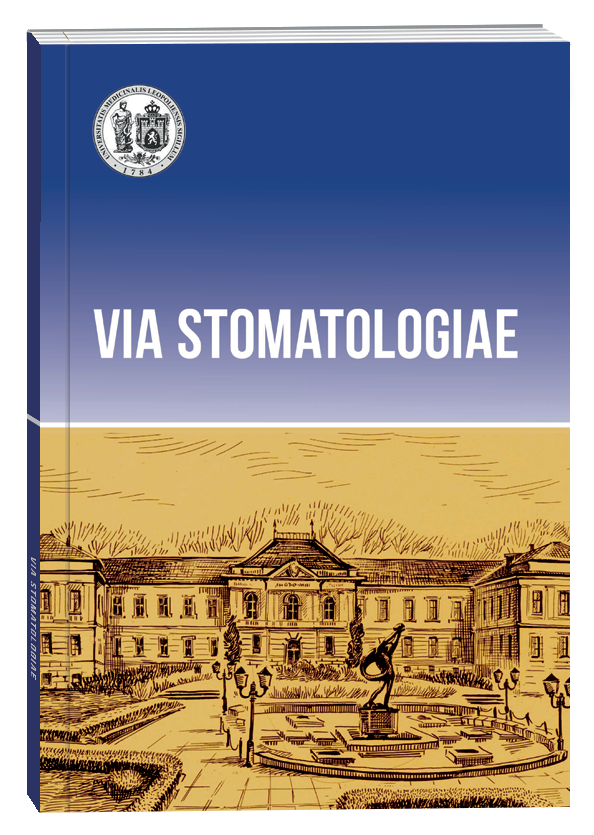THE RESULTS OF THE EXPERIMENTAL-CLINICAL STUDY OF THE STATE THE TISSUE INTERFACE OF ENDOOSTEAL IMPLANTS IN AXIAL AND NON-AXIAL FUNCTIONAL LOADING (OVERVIEW OF THE CURRENT STATE OF THE PROBLEM)
DOI:
https://doi.org/10.32782/3041-1394.2024-1.1Keywords:
dental implant, implant-bone tissue interface, axial and non-axial functional loading of implantsAbstract
In modern diagnostic and treatment protocols for dental implantation, attention is focused on taking into account both morphological and functional factors to achieve long-term clinical effectiveness of this treatment technology. The lack of ensuring functionally oriented positioning of dental implants (DI) and prosthetic structures leads to frequent complications in clinical practice with surgical interventions, which are difficult to correct, and the results of applied prosthetics negatively change the functional endurance of the peri-implant tissue environment with early explantation of DI. In this regard, many efforts of specialists are directed to the experimental study of the features of the distribution of the functional load of the DI in the surrounding bone tissue with an attempt to extrapolate the obtained data into clinical practice to optimize the location of the prosthetic structures used in this cases. Studies of the dysfunctional impact of the load in the areas of the inclined planes of the occlusal surfaces have been carried out of prosthetic structures proved the presence of an increase in the concentrated horizontal component of the DI load, as a result of which compressive and tensile deformation forces increase, which cause resorption of the alveolar bone tissue of the jaws. It has been established that an increase in lateral load vectors at the bone-implant interface occurs during implantation immediately after tooth extraction. At the same time, bone tissue repair leads to a loss of the marginal level, and as a result, crowns on DI are made larger than the crowns of existing teeth, which can secondarily involve growth harmful effects of deformation vectors. In connection with the existence today of controversial interpretations regarding the results of the long-term influence of the functional load of the DI on the state of the peri-implant tissue interface, the need for modern experimental morphological, x-ray graphic and histomorphometric analysis of the indicators of the DI interface located in axial and paraaxial positions along the perimeter of contact with the surrounding bone.
References
Flemming I.Influence of forces on peri-implant bone (2006). Clinical Oral Implants Research 17 (Suppl. 2), 8–18.
Degidi M., Scarano A., Piattelli M., Perrotti V., Piattelli A. (2005). Bone remodeling in immediately loaded and unloaded titanium dental implants: a histologic and histomorphometric study in humans. Journal of Oral Implantology, 31, 18–24.
Manea A., Bran S., Cristian D., Rotaru H., Barbur I, Crisan B., Armencea G., Onisor F., Lazar M., Ostas D., Baciut M., Vacaras S., Mitre I., Liana C., Muresan O., Roman R., Baciut G. (2019). Principles of biomechanics in oral implantology, Medecine and pharmacy reports., 92 (Suppl.), 3, 14–19.
Misch C.E., Suzuki J.B., Misch-Dietsh F.M., Bidez M.W. (2005). A positive correlation between occlusal trauma and peri-implant bone loss: literature support. Implant Dentistry, 14, 108–116.
Kitamura E., Stegaroiu R., Nomura S. & Miyakawa O. (2004). Biomechanical aspects of marginal bone resorption around osseointegrated implants: considerations based on a three-dimensional finite element analysis. Clinical Oral Implants Research, 15, 401–412.
Watzak G., Zechner W., Ulm C., Tangl S., Tepper, G. & Watzek G. (2005). Histologic and histomorphometric analysis of three types of dental implants following 18 months of occlusal loading: a preliminary study in baboons. Clinical Oral Implants Research, 16, 408–416.
Zechner W., Trinkl N., Watzak G., Busenlechner D., Tepper G., Haas R., Watzek G. (2004). Radiologic follow-up of peri-implant bone loss around machine-surfaced and roughsurfaced interforaminal implants in the mandible functionally loaded for 3 to 7 years. International Journal of Oral & Maxillofacial Implants, 1(19), 216–221.
Roberts W.E., Turley P.K., Brezniak N. & Fielder P.J. (1987). Implants: bone physiology and metabolism. Journal of the California Dental Association, 15, 54–61.
Podaropoulos L., Veis A.A., Trisi P.; Papadimitriou S., Alexandridis C., Kalyvas D. (2016). Bone reactions around dental implants subjected to progressive static load: An experimental study in dogs. Clin. Oral Implants Res., 27(3), 910–917.
Duyck J., Vrielinck,L., Lambrichts I., Abe Y., Schepers S., Politis C. Naert I. (2005). Biologic response of immediately versus delayed loaded implants supporting ill-fitting prostheses: an animal study. Clinical Implant Dentistry and Related Research, 7, 150–158.
Quinlan P., Nummikoski P., Schenk R., Cagna D., Mellonig J., Higginbottom, F., Lang K., Buser D. Cochran D. (2005). Immediate and early loading of SLA ITI single-tooth implants: an in vivo study. International Journal of Oral & Maxillofacial Implants, 20, 360–370.
Buchter A., Wiechmann D., Koerdt S., Wiesmann H.P., Piffko J. Meyer U. (2005). Load-related implant reaction of mini-implants used for orthodontic anchorage. Clinical Oral Implants Research, 16, 473–479.
Duyck J., Vandamme K., Geris L., Van Oosterwyck H., De Cooman M., Vander Sloten J., Puers R., Naert I. (2006). The influence of micro-motion on the tissue differentiation around immediately loaded cylindrical turned titanium implants. Archives of Oral Biology, 51, 1–9.
Вовк Ю.В., Вовк В.Ю. (2017). Експериментальне дослідження стану кісткової тканини при впливі тривалого функціонального навантаження на дентальні імплантати, уведені з різностороннім нахилом. Новини стоматології, 2 (91), 62–70.
Decker AМ, Sheridan R., Lin G.H., Sutthiboonyapan P., Carroll W., Wang H.L. (2015). Prognosis System for Periimplant Diseases. Implant Dentistry, 24(4), 416–421.
Roberts W.E., Smith R.K., Zilberman Y., Mozsary P.G., Smith R.S. (1984). Osseous adaptation continuous loading of rigid endosseous implants. American Journal of Orthodontics and Dentofacial Orthopedics, 86, 95–111.
Stahl, E., Keilig, L., Abdelgader, I., Jager, A., Bouraue, l.C. (2009). Numerical analyses of biomechanical behaviour of various orthodontic anchorage implants. Journal of Orofacial Orthopedics, 70, 115–127.
Wilmes B., Su Y.Y., Drescher D. (2008). Insertion angle impact on primary stability of orthodontic mini-implants. Angle Orthodontics, 1(78), 1065–1070.
van Staden R.C., Guan H., Johnson N.W., Loo Y.C., Meredith, N. (2008). Step-wise analysis of the dental implant insertion process using the finite element technique. Clinical Oral Implants Research, 19, 303–313.
Chrcanovic B. R., Albrektsson T., Wennerberg A. (2015). Tilted versus axially placed dental implants: A meta-analysis Review Journal of Dentistry, 43(2), 149–170.
Vidyasagar, L. Apse, P. (2003). Biological response to dental implant loading/overloading.Implant overloading: empiricism or science? Stomatologija, 5(3), 83–89.
Roberts W.E., Smith R.K., Zilberman,Y., Mozsary P.G., Smith R.S. (1984). Osseous adaptation continuous loading of rigid endosseous implants. American Journal of Orthodontics and Dentofacial Orthopedics, 86, 95–111.
Page H.L. (1952). The occlusal curve.Dental digest., 3, 19–22.
Orthlieb J.-D. (1997). The curve Spee: understanding the sagittal organization of mandibular teeth. The Journal of Craniomandibular Practice, 4, 333–34.
Ré J.-Ph., Foti B., Glise J.-M., Orthlieb J.-D. (2015). Optimal placement of the two anterior implants for the mandibular All-on-4 concept J. Prosthet Dent., 114, 17–21.
Krekmanov L., Kahn M., Rangert B., Lindstrom H. (2000). Tilting of posterior mandibular and maxillary implants of improved prosthesis support. Int. J. Oral. Maxillofac. Implants, 15(2), 405–414.
Sebaoun J.D., Kantarci A., Turner J.W., Carvalho R.S., Van Dyke T.E., Ferguson D.J. (2008). Modeling of trabecular bone and lamina dura following selective alveolar decortication in rats. J. Periodontol., 79(9), 1679–1688.
Chun H.J., Shin H.S., Han C.H., Lee S.H. (2006). Influence of implant abutment type on stress distribution in bone under various loading conditions using finite element analysis. Int J Oral Maxillofac Implants, 21(2), 195–202.
Calandriello R, Tomatis M. (2005). Simplified treatment of the atrophic posterior maxilla via immediate/early function and tilted implants: a prospective 1-year clinical study. Clinical Implant Dentistry and Related Research, 7, 1–12.
Capelli M, Zuffetti F, Del Fabbro M, Testori T. (2007). Immediate rehabilitation of the completely edentulous jaw with fixed prostheses supported by either upright or tilted implants: a multicenter clinical study. International Journal of Oral and Maxillofacial Implants, 22, 639–644.
Malo ́ P, de Arau ́jo Nobre M, Lopes A. (2007). The use of computer-guided flapless implant surgery and four implants placed in immediate function to support a fixed denture: preliminary results after a mean follow-up period of thirteen months. Journal of Prosthetic Dentistry, 97, 26–34.
Agliardi EL, Francetti L, Romeo D, Taschieri S, Del Fabbro M. (2021). Immediate loading in the fully edentulous maxilla without bone grafting: the V-II-V technique. Minerva Stomatologica, 57(2), 59–63.
Francetti L, Agliardi E, Testori T, Romeo D, Taschieri S, Del Fabbro M. (2008). Immediate rehabilitation of the mandible with fixed full prosthesis supported by axial and tilted implants: interim results of a single cohort prospective study. Clinical Implant Dentistry and Related Research, 10(2), 255–263.
Tealdo T., Bevilacqua M., Pera F., Menini M., Ravera G., Drago C. (2008). Immediate function with fixed implant-supported maxillary dentures: a 12-month pilot study. Journal of Prosthetic Dentistry, 99, 351–360.
Testori T., Del Fabbro M., Capelli M., Zuffetti F., Francetti L., Weinstein R. (2010). Immediate occlusal loading and tilted implants for the rehabilitation of the atrophic edentulous maxilla: 1-year interim results of a multicenter prospective study. Clinical Oral Implants Research, 19(2), 227–232.
Chrcanovic B. R., Albrektsson T., Wennerberg A. (2015). Bruxism and Dental Implants: A Meta-Analysis, 243(5), 505–516.
Krekmanov L., Kahn M., Rangert B., Lindström H. (2000). Tilting of posterior mandibular and maxillary implants for improved prosthesis support. Oral Maxillofac Implants, 15(3), 405–414.
Calandriello R, Tomatis M. (2005). Simplified treatment of the atrophic posterior maxilla via immediate/early function and tilted implants: a prospective 1-year clinical study. Clinical Implant Dentistry and Related Research, 7, 1–12.
Koutouzis T., Wennstrom J.L. (2007). Bone level changes at axial- and non-axial-positioned implants supporting fixed partial dentures. A 5-year retrospective longitudinal study. Clinical Oral Implants Research, 18, 585–590.
Kawasaki T., Komatsu K., Tsuchiya R. (2011). Tilted placement of tapered implants using a modified surgical template. Journal of Oral and Maxillofacial Surgery, 69, 1642–1650.
Cavalli N., Barbaro B., Spasari D., Azzola F., Ciatti A., Francetti L. (2012). Tilted implants for full-arch rehabilitations in completely edentulous maxilla: a retrospective study. International Journal of Dentistry Article, ID 180379, 6.







